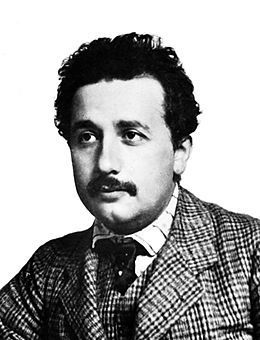Special relativity facts for kids
The theory of special relativity was explained by Albert Einstein in 1905, in his paper On the Electrodynamics of Moving Bodies. Einstein said that special relativity is based on two ideas:
- Relativity: the relationship between motion and the observer. The laws of physics are the same for all observers that are not moving in relation to (relative to) each other.
- Speed of light: both distance measurements and time measurements change when they travel near the speed of light. This means that as one gets closer to the speed of light (about 186,000 miles per second), lengths look like they are getting shorter, and clocks seem to tick more slowly.
Contents
Relativity
Objects moving in the same direction at the same speed are said to be in an "inertial frame." Because they are moving together at the same speed and distance, they do not look like they are moving to each other (those that are inside that frame). It is similar to people traveling together in a car (the same frame). The car is traveling in one direction at a certain speed (let's say 50 mph), but the passengers, who are in the same "inertial frame," feel like they are sitting still. However, to an observer standing outside the car, the passengers are moving at 50 mph: the same speed that the car is moving, relative (compared) to the person who is standing still. If someone in the front seat were to toss a snack to the back seat, the movement would look different to the passengers than it would to the observer who is standing outside the car. The passengers in the back seat would see the snack flying backward toward them at approximately 40 mph since they are in the same "inertial frame" as the car. The person standing outside of the car (outside the frame) would see the snack fly at approximately 10 mph in the same direction in which the car is traveling (50 mph - 40 mph in the opposite direction). People in the same "frame" measure how long something takes to happen. Their clocks keep the same time. But in another "frame," their clocks move at a different rate.
Speed of Light
Before Albert Einstein, scientists were trying to measure the "relative speed" of light. They were doing this by measuring the speed of starlight reaching the Earth. They expected that if the Earth was moving toward a star, the light from that star should reach them faster than if the Earth was moving away from that star. However, they noticed that no matter who performed the experiments, where the experiments were performed, or what starlight was used, the measured speed of light in a vacuum was always the same. No matter how an observer is moving, if he measures the speed of the light coming from that star, it will always be the same number.
Events that appear to be happening at the same time in one frame may not be happening at the same time in another frame. This has many effects that are not easy to see or understand. Since the length of an object is the distance from one end to the other in an exact moment of time, if two observers are traveling at different (extremely fast) speeds, they may disagree on the length of the object they are observing. Here is another example: If a long line of clocks appears synchronized to an observer who is not moving and appears to be out of sync to that same observer after accelerating (speeding up) to a certain velocity, then it looks like the clocks run at different speeds during acceleration.
Other scientists before Einstein had written about light seeming to go the same speed no matter how it was observed. What made Einstein's theory so new and important is that it considers the measurement of the speed of light to be constant by definition. In other words, it is a law of nature.
Special relativity also relates energy with mass, in Albert Einstein's E=mc2 formula.
Interesting Facts about Relativity
- Relativity can be defined by this example: “When you are courting a nice girl, an hour seems like a second. When you sit on a red-hot cinder, a second seems like an hour.”
- Special relativity applies to "special" cases — it's mostly used when discussing huge energies, ultra-fast speeds and astronomical distances, all without the complications of gravity.
- The word "relativity" did not appear in Einstein's famous 1905 paper On the Electrodynamics of Moving Bodies. He preferred the term “invariance theory.”
- Special relativity shows why events may appear to happen at the same time to one observer and appear to happen at different times to another observer.
Related pages
Images for kids
-
Figure 4–1. The three events (A, B, C) are simultaneous in the reference frame of some observer O. In a reference frame moving at v = 0.3c, as measured by O, the events occur in the order C, B, A. In a reference frame moving at v = −0.5c with respect to O, the events occur in the order A, B, C. The white lines, the lines of simultaneity, move from the past to the future in the respective frames (green coordinate axes), highlighting events residing on them. They are the locus of all events occurring at the same time in the respective frame. The gray area is the light cone with respect to the origin of all considered frames.
-
Figure 5-5. Galaxy M87 streams out a black-hole-powered jet of electrons and other sub-atomic particles traveling at nearly the speed of light.
See also
 In Spanish: Teoría de la relatividad especial para niños
In Spanish: Teoría de la relatividad especial para niños





